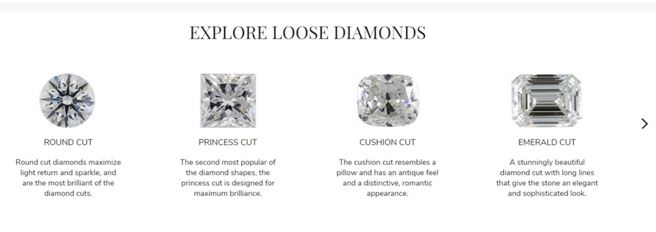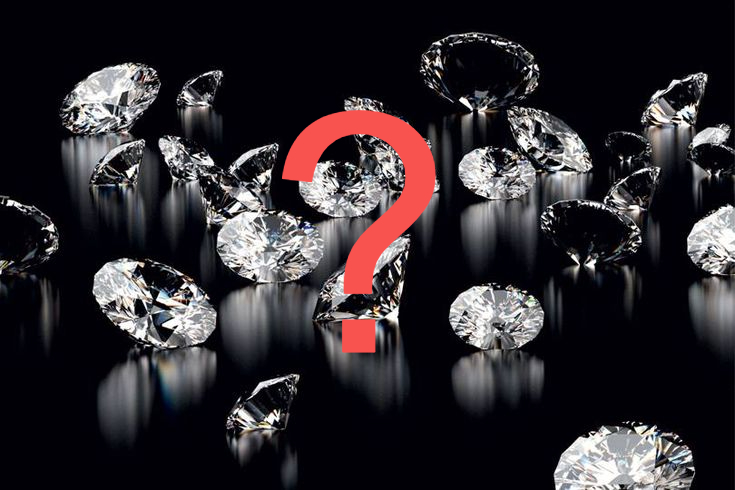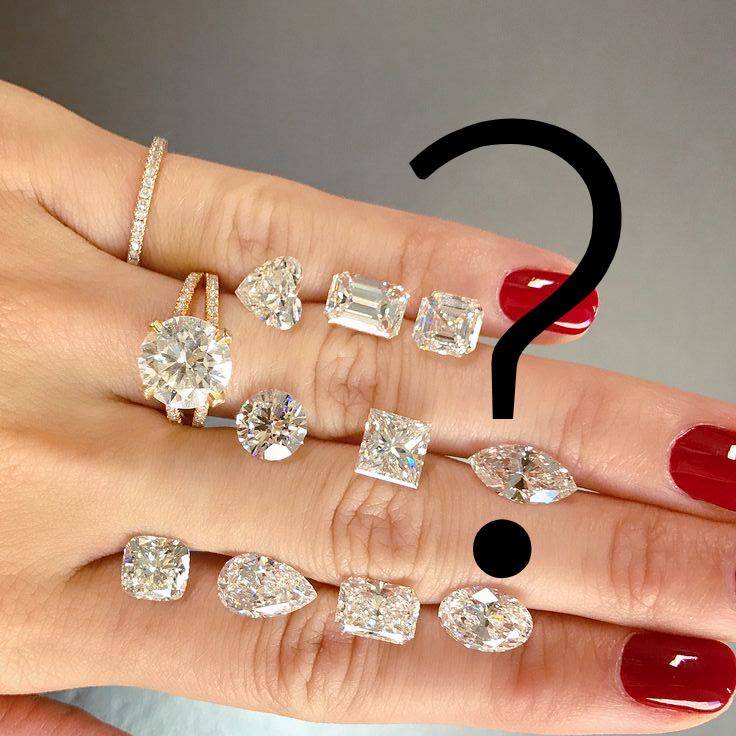Everyone wants a clean, colorless and clear diamond. But does everyone really need one?
This article would expose your mind to the most important things you need to know about diamond clarity.
- You would understand what diamond clarity is
- You would also understand what imperfections are, how they come about, and the different types which are:
- External (blemishes)
- Internal (Inclusions)
- You would know why understanding diamond clarity is important. The reasons discussed are:
- It helps you to save more and still get value
- You would know what to look for in terms of clarity when buying a diamond
- You get to understand how each inclusion can be unique to your diamond
- Maximize the diamond position to hide inclusions
- Detect counterfeit GIA reports
- We would also discuss the GIA clarity grading scale. The grades are:
- Flawless (FL): The cleanest diamonds in existence. They have no external or internal imperfection whatsoever and they are very rare
- Internally Flawless (IF): A very clean diamond, no internal flaw at 10x magnification. Diamonds in this class are also very rare.
- Very Very Slightly Included 1 and 2 (VVS1 and VVS2): Refers to a grade with excellent quality and good value for money. It allows the buyer to explore other diamond characteristics. Diamonds in this class are eye-clean diamonds
- Very Slightly Included 1 and 2 (VS1 and VS2): refers to the most popular diamonds in demand. This grade achieves a perfect balance between clarity and other characteristics
- Slightly Included 1 and 2 (SI1 and SI2): Inclusions here are easily detectable under 10x magnification but not easily seen with the naked eye.
- Included 1, 2 and 3 (I1, I2, and I3): This diamond grade contains imperfections that affect the structure and brilliance. They are not very popular among people as jewelry.
- We then discuss the factors that affect diamond grading such as:
- Size
- Number
- Position
- Nature
- Relief
- We would finally wrap up this discussion on diamond clarity by examining clarity enhancement methods which include:
- Laser drilling: A hole is drilled into the diamond and the inclusion is washed away. This method is regarded as permanent and is graded by the GIA.
- Fracture filling: A fracture in the diamond is filled using filler agents. This method is seen as temporary and is NOT graded by the GIA.
Now, What is Diamond Clarity?
Simply put, diamond clarity refers to the absence of imperfections in the diamond. It is one of the 4Cs of the diamond and should also be considered in making the choice of which diamond to buy. When these imperfections are internal within the diamond, they are termed as Inclusions. When they are on the surface of the diamond, they are referred to as Blemishes.
One might ask, ‘how do we come about imperfections in diamonds?’
Well, this takes us back to the formation of diamonds. We know that diamonds are formed from carbon, an element. During the process of diamond formation, this carbon is acted upon by several forces at extremely high temperatures. In this process, some of the gases, solids or liquids produced might get wrapped up in the structure of the diamond. When this happens, inclusions can be formed. Blemishes can also result when compact forces act on the surface of the diamond.
The imperfections that are formed are sometimes called the ‘birthmarks’ of the diamond and can serve as a distinguishing feature of the diamond. They are not usually visible and do not affect the sparkle and visual appeal of the diamond.
However, some diamonds have been heavily dented by the imperfections that they contain, such that their brilliance is impeded.
WHY YOU MUST UNDERSTAND DIAMOND CLARITY
A very good understanding of the concept of diamond clarity would help you to:
- Save More and still get value: Diamond clarity is considered by many as the third most important of the 4Cs. This might vary, however, depending on what you need the diamond for. But, since most of the inclusions are usually not visible to the eye, one can go for a lower clarity grade and increase the cut grade, or even the carat.
- Know what to look for in buying a diamond: When you go to your dealer or when you visit a diamond shop online, you must know exactly what to check for so that you get a diamond that you appreciate or that is appreciated by the one you are buying it for.
- Understand how inclusions contribute to the uniqueness of your diamond: Not every diamond is going to be flawless. As a matter of fact, most diamonds are not. Therefore, the blemish or inclusion if well situated can be something that marks your stone out, you could think of it as the ‘fingerprint’ of your diamond.
- Utilize imperfections: Of course, nothing is ever truly useless. With the right setting, the flaws in your diamond can be hidden while the beautiful flawless parts are exposed to observers. Most people would never know it is not totally flawless. Instead, the imperfections present can become a centerpiece for a new setting designed to mask the flaw.
- Know one of the ways to detect counterfeit GIA reports, using some information obtained from clarity.
Now that we understand how important diamond clarity can be, we now proceed to look at the types of imperfections present in diamonds.
As we have said earlier, imperfections can either be inclusions or blemishes.
Examples of inclusions include: Feather, needle, crystal, cloud, pinpoint, knots, cavities, cleavage, Bearding, Laser lines
Examples of blemishes include Naturals, scratches, nicks, chips, breaks, dark spots, pits, polish lines, breaks, and abrasions.
GIA CLARITY GRADING
In grading clarity, the GIA has put forward a scale that is recognized worldwide as the standard and authority on diamond clarity matters.
It is also important to note that even though most diamonds contain some form of imperfection, these imperfections largely do not affect the sparkle of the diamond. They are usually silent and do not also affect the structure of the diamond.
That said, there are some however that do affect the light performance of the diamond and could make the diamond appear duller and less appealing to the observer.
The GIA diamond grading scale for clarity was first put forward in 1952 by Richard Liddicoat and his team, who were working on a better way of evaluating and accessing diamonds. The make, the color, and clarity were the things they were working on.
In 1970, clarity was then modified as they added a new category to the existing ones.
The last modification was in 1990, which has now left us with what we have now; the GIA clarity scale.
The grading is carried out under10x magnification, under darkfield illumination. After a critical examination of all the sectors of the diamond, the diamond is then placed into any of the following grades:
- Flawless (FL): Diamonds in this category have no blemish or inclusion whatsoever. Even at 10x magnification, no imperfections can be visualized. Less than 0.1% of all diamonds available today fall into this category. The diamonds are of premium quality and are very expensive because of their clarity grade.
- Internally Flawless (IF): This group of diamonds as the name implies, is internally flawless; the diamonds have no inclusions that are visible to the naked eye. The blemishes present can only be seen under 10x magnification by a well-trained gemmologist. The imperfections present do not reduce the sparkle or interfere with the light performance of the diamond.
- Very Very slightly Included (VVS1): The very very slightly included grade is one with minute inclusions which are only visible under 10x magnification. The inclusions are usually only visible through the pavilion at 10x. The most common inclusions seen here are the natural and the pinpoint and they do not impede the light performance of the stone. Actually, VVS1 diamonds are very valuable because they can save you more. On observation with the naked eye, there would most likely be no difference between an FL, IF and VVS1 diamond. Therefore, you can save more by going for a VVS1 and then exploring a higher grade cut or color.
- VERY VERY SLIGHTLY INCLUDED 2: This grade has minute inclusions which are more visible than the VVS1 under 10x magnification. The inclusions are not visible to the naked eye and this grade is regarded as one that provides the best value among the higher grade clarities without compromising the brilliance and quality of the diamond. The most common inclusions that are seen in this grade include: natural, pinpoint, cloud and feather.
- VERY SLIGHTLY INCLUDED (VS1 AND VS2): Now we have come to the most popular grade in terms of clarity. The VS1 has minor inclusions that are invisible to the naked eye but can be picked under 10x magnification. The VS2 also has minor inclusions which are only picked at 10x magnification, however, the inclusions in VS2 are larger. These two grades allow the perfect combination of the other Cs of diamonds and as a result, many people want to have them. The inclusions have an unnoticeable effect on the brilliance and sparkle of the diamond. The most common inclusions seen in this grade include feather, crystal, indented natural, and cloud.
- SLIGHTLY INCLUDED (SI): This grade has a higher grade, SI1, and the lower SI2 grade. The inclusions here are easily detectable under 10x magnification and might be noticeable with the naked eye. The SI grade also affords potential buyers the freedom to explore other characteristics like cut and color to get better value for money.
- INCLUDED (I): This grade refers to diamonds that have inclusions that are obvious to an unaided eye. This grade has three categories: I1 which has the highest clarity, I2 and then I3 which is the lowest clarity grade. Diamonds in this grade show inclusion which are capable of affecting the stability and structure of the stone and also affecting its brilliance.
Diamonds that belong to the flawless and internally flawless grade are rare. They, therefore, have a premium value attached. Just about 20% of the diamonds have clarity grade quality that qualifies for use as gemstones. Most of the other 80% are limited to industrial uses. Out of the 20%, there are those referred to as ‘eye-clean’. These eye-clean diamonds are diamonds that appear clean (no imperfections visible) to the naked eye when placed at about 6cm from the eyes.
Diamond cutters have also perfected techniques for hiding flaws in diamonds. Even if a diamond has some inclusions, it can be placed in a setting that helps to mask the flaw so it is not visible.
FACTORS CONSIDERED IN GRADING CLARITY
As a standardized assessment method, there are five factors that GIA considers when accessing the clarity of a diamond. Based on these factors, a diamond would be assigned to a clarity grade. These factors are:
- SIZE: Undoubtedly, the larger an imperfection, the more obvious it gets and the more the brilliance of the diamond is affected. As a factor that is considered in grading, the diamonds with larger inclusions are put in a lower clarity grade, while those with minute inclusions are placed in higher clarity grades.
- NUMBER: The higher the number of inclusions or blemishes in a diamond, the lower the clarity grade and vice versa. The assessment of the number is not so much about how many imperfections can be seen, rather, it is an assessment of how readily they can be seen.
- POSITION: The position of imperfection would definitely affect its clarity grading. For instance, an inclusion positioned right under the table of a diamond would be very visible. This would lower the clarity rating. An inclusion placed below the crown or the girdle would not be very visible and so, even though it has imperfections, it would still be rated higher on the clarity rating scale. Imperfections at the pavilion significantly affect the brilliance of a diamond because it would reflect multiple times.
- NATURE: The nature of the imperfection would determine the class of the diamond. If it is an internal imperfection (inclusion), then the diamond cannot be included in the Flawless or Internally flawless category. Still, on nature, some inclusions also have the tendency to damage the structure of the stone. Examples include: cleavage, feather, knot, included crystals. When they are present, the diamond is graded lower on the clarity scale.
- RELIEF: Relief refers to the color of an inclusion. Some inclusions would have colors that contrast with the surrounding diamond. When this happens, the inclusion stands out and is more visible to an observer. This inclusion would distract from the brilliance of the stone. Diamonds with imperfections that have relief are also classified lower in the clarity grading scale.
When all of these factors are put together, we can understand why a particular diamond is placed in a clarity grade. We can also use these factors as a guide in selecting the type of diamond to buy and what to expect when taking a diamond for certification.
CLARITY ENHANCEMENT
As technological advancements are made, diamond vendors and reputable companies constantly seek a way to enhance the appearance of diamonds. This has led to methods that help to enhance the clarity of diamonds.
- LASER DRILLING: This method involves the use of a laser to drill a hole in the diamond, up to the point of the inclusion. The inclusion is then washed off using acid agents and then the grade after the treatment becomes the clarity grade of the stone. This method is considered to be a permanent method and so the GIA grades laser filled diamond.
- FILLING: In this method, a particular fracture or imperfection in the diamond is filled with filling agents. Such diamonds are usually labeled and potential buyers are informed before they buy. It is important to note that the GIA does not grade fracture-filled diamonds. The treatment is considered to be temporary because the filling agent does not usually last up to the diamond itself. Heat can also damage the filled diamond so that the fracture or imperfection reappears.
It, therefore, follows that any GIA report for a fracture-filled diamond is fake because GIA does not even grade them in the first place! This way, you can filter any report that carries a ‘fracture-filled’ or similar clarity scale.
In conclusion, the clarity of a diamond greatly affects the brilliance and light performance of the diamonds. The clarity scale by GIA is to guide your choice in selecting a diamond. You must determine how much inclusion or blemish you are willing to allow and how they affect the use of the diamond. The environment or setting of the diamond is also another thing to be considered.
Whichever you choose, make sure you consult with your gemmologist so you can be guided on the best to choose.
Remember, you can always save more with diamond clarity!



